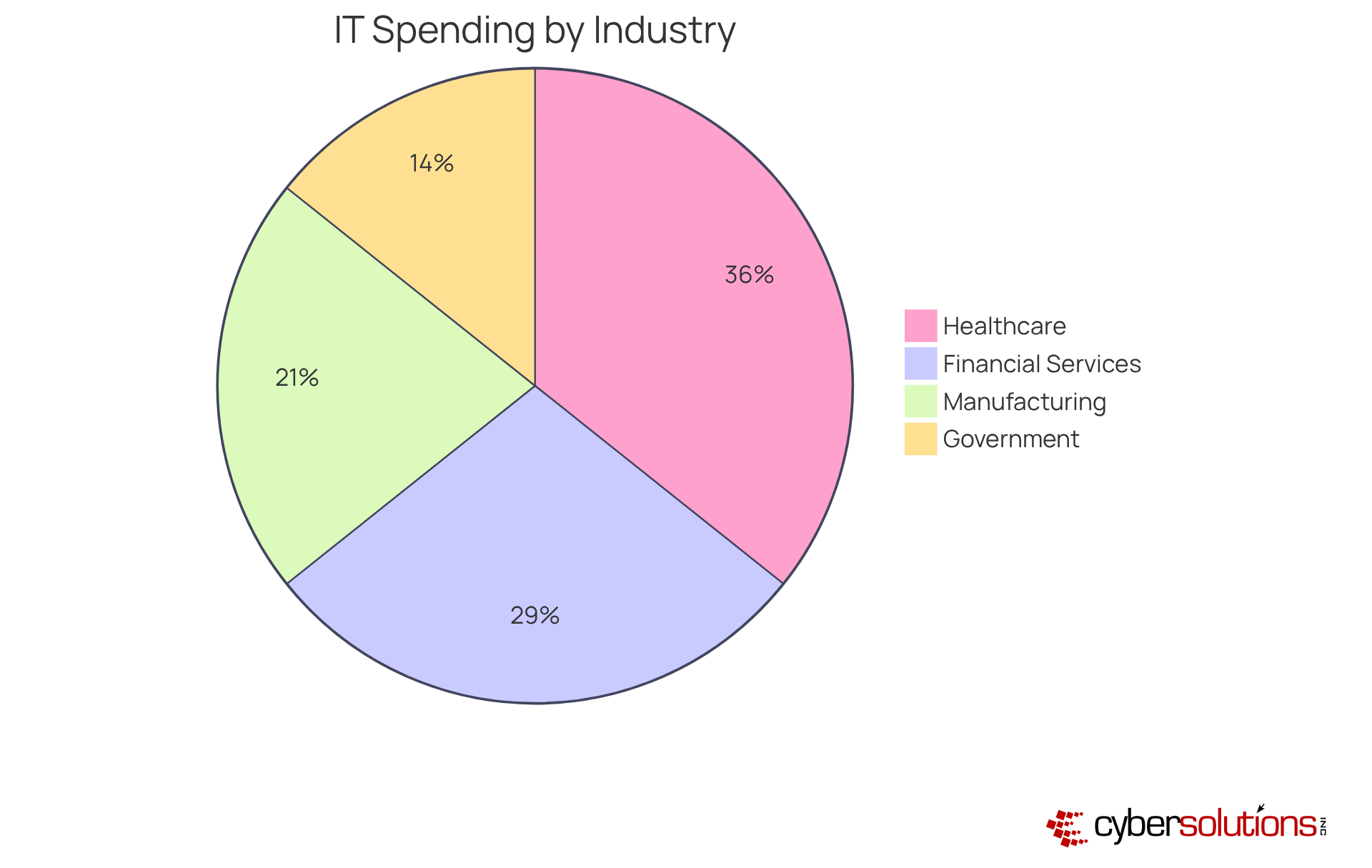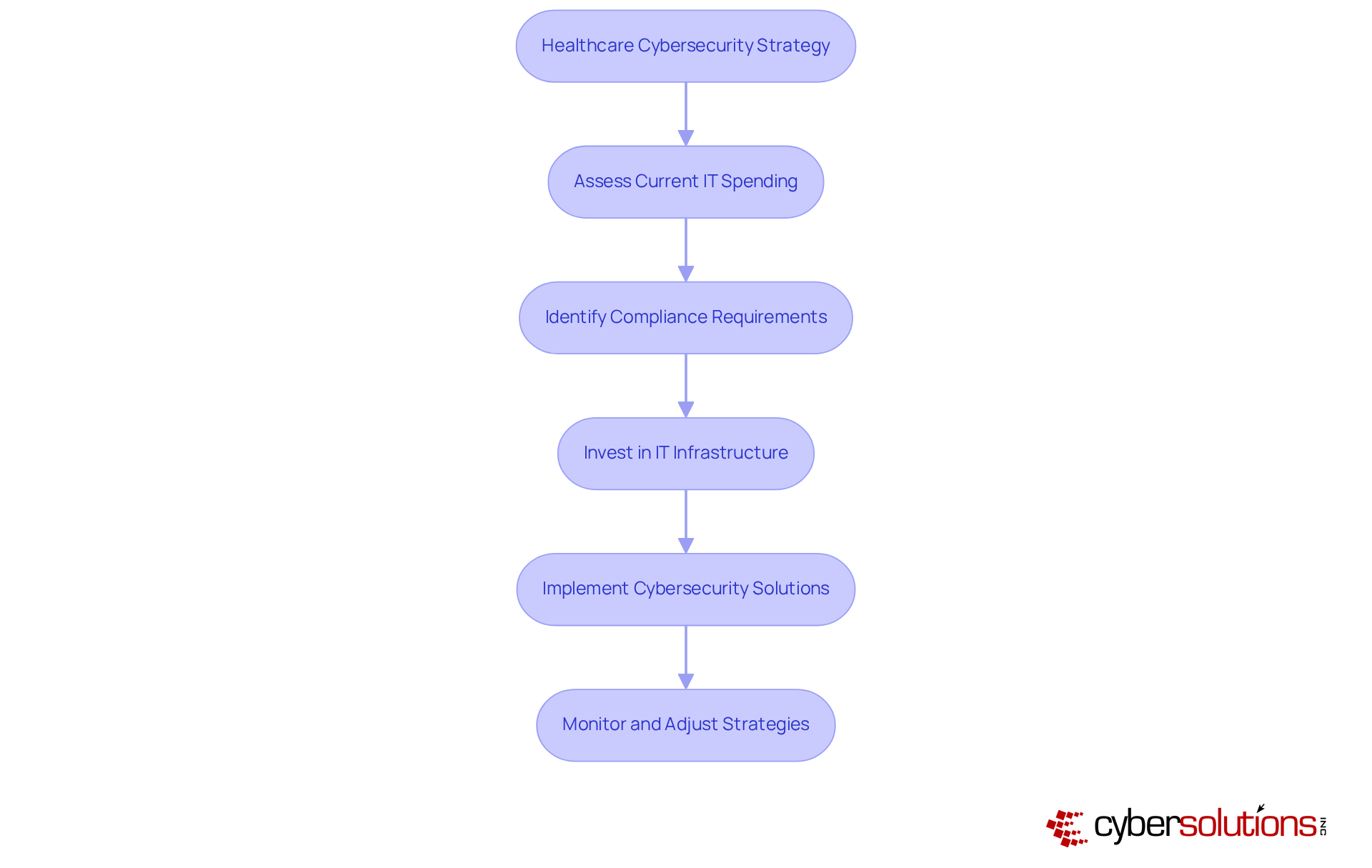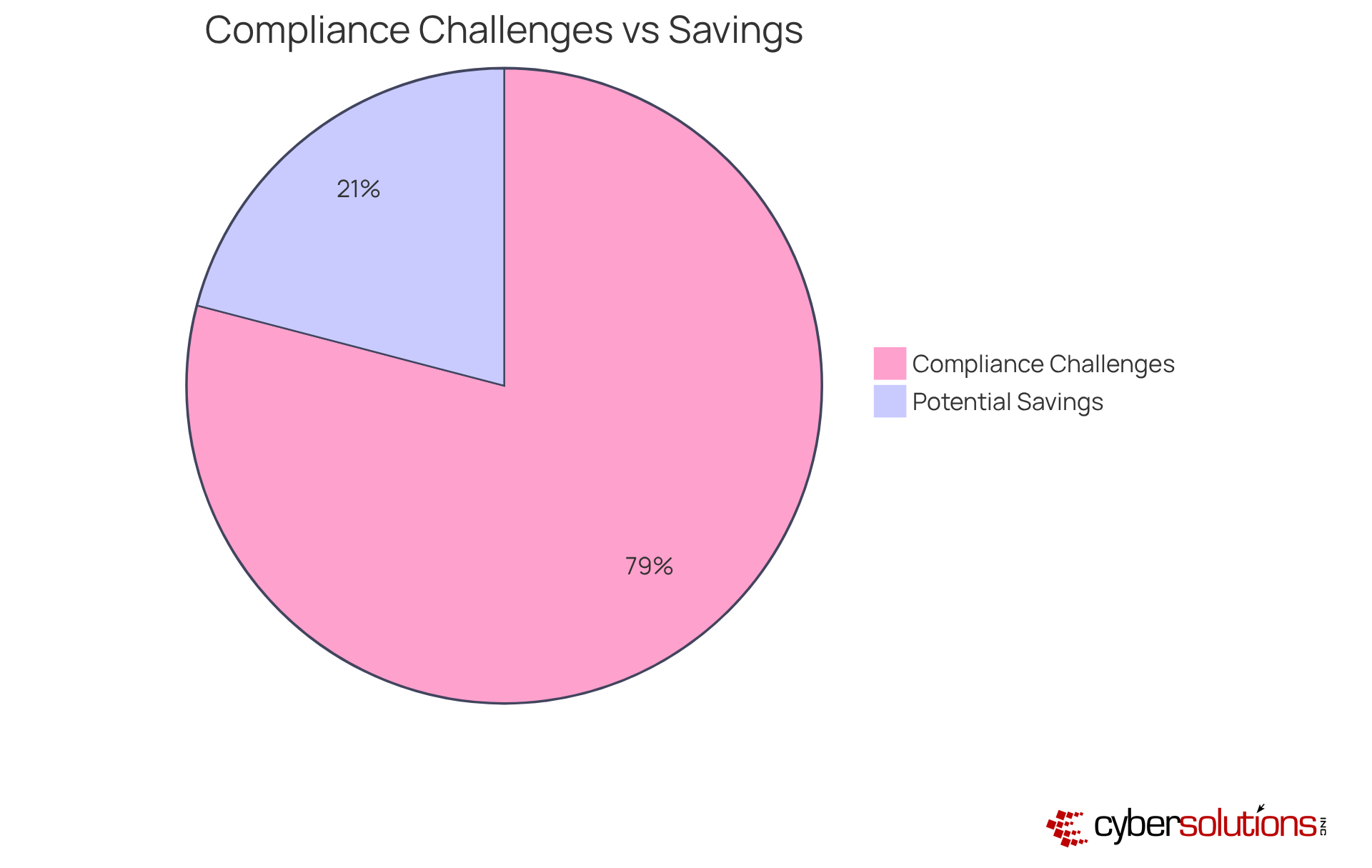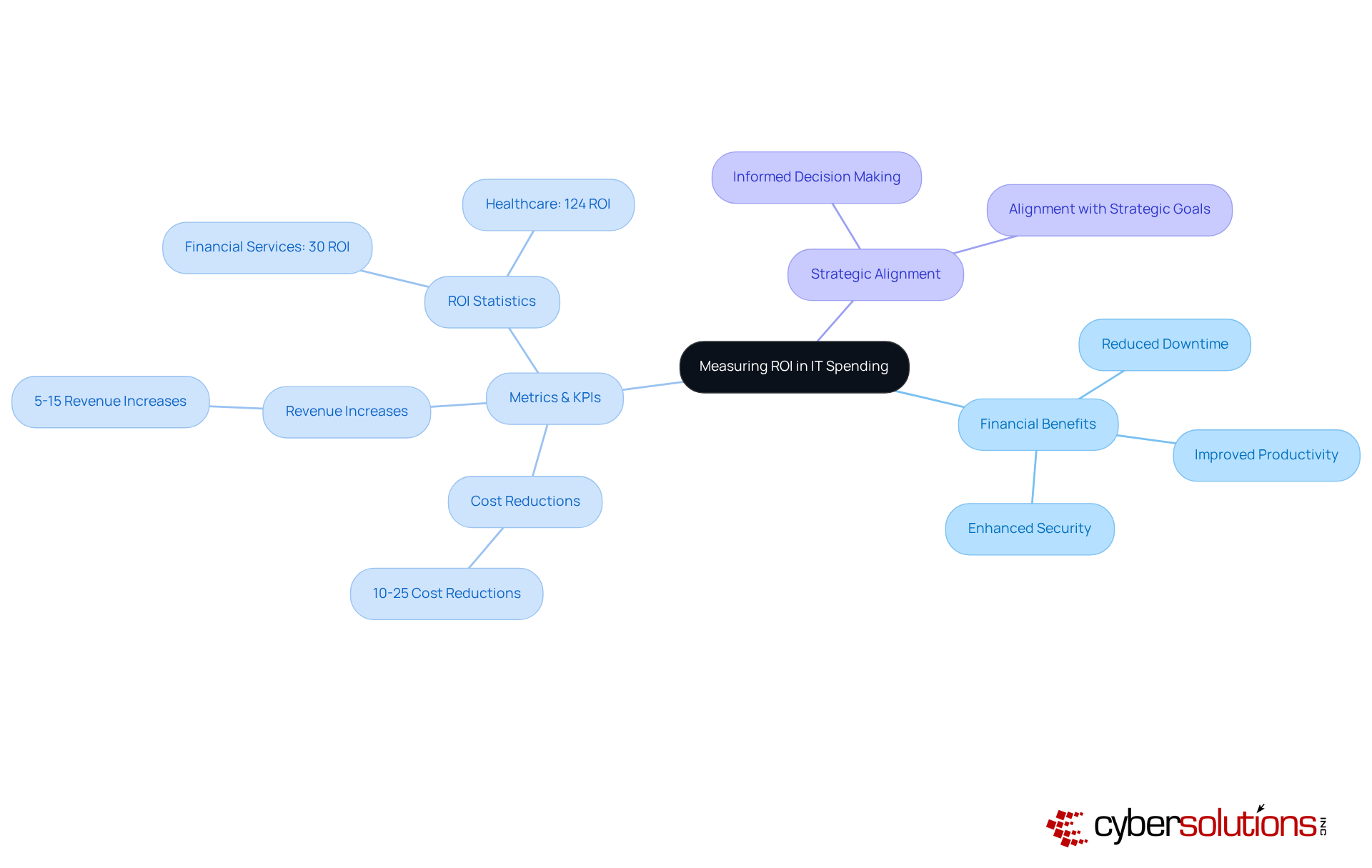
As organizations face the mounting pressures of cybersecurity and regulatory compliance, the significance of understanding IT spending as a percentage of revenue by industry has reached a critical juncture. In particular, the healthcare sector grapples with unique challenges that demand tailored strategies to optimize budget allocations and bolster operational resilience. With the stakes soaring, how can CFOs effectively navigate these complexities while ensuring a robust return on investment?
The current landscape of cybersecurity threats is daunting, especially for healthcare organizations that handle sensitive patient data. The implications of these threats extend beyond financial loss; they can jeopardize patient trust and regulatory standing. Therefore, it is imperative for organizations to adopt a proactive approach to cybersecurity, integrating comprehensive solutions that address these vulnerabilities head-on.
Cyber Solutions can play a pivotal role in this endeavor. By leveraging data-driven insights and industry-specific strategies, organizations can not only enhance their security posture but also streamline their IT expenditures. This dual focus on security and efficiency is essential for maximizing value in an increasingly complex environment.
In conclusion, as the demand for cybersecurity intensifies, organizations must prioritize their IT investments wisely. By understanding the nuances of their industry and implementing tailored strategies, they can navigate the challenges ahead and secure a competitive edge.
In today's digital landscape, cybersecurity is not just a technical necessity; it's a critical component of operational integrity, especially in healthcare. With increasing threats targeting sensitive patient data, healthcare organizations face unique challenges that demand immediate attention from CFOs and IT leaders alike.
Healthcare institutions must navigate a complex web of regulations while ensuring data security. For instance, the stakes are high when it comes to compliance with HIPAA and other regulatory frameworks. Failure to adhere to these standards can lead to severe penalties and loss of trust. How can organizations effectively allocate their IT budgets while considering IT spending as a percentage of revenue by industry to address these pressing concerns?
Cyber Solutions Inc. offers a tailored approach to IT spending, recognizing that different sectors have distinct needs. Our customized IT services are designed to meet the specific security and regulatory requirements of healthcare, financial services, manufacturing, and government. By analyzing industry-specific benchmarks, we empower clients to allocate their IT budgets effectively, ensuring that investments align with both operational goals and regulatory mandates, particularly by evaluating IT spending as a percentage of revenue by industry.
To combat unauthorized software and enhance cybersecurity, we implement proactive strategies such as:
These measures not only mitigate risks but also bolster overall business performance, providing a strategic advantage for our clients across various sectors.
In conclusion, as cybersecurity threats continue to evolve, partnering with Cyber Solutions can help healthcare organizations navigate these challenges effectively. Are you ready to enhance your cybersecurity posture and ensure compliance? Let's discuss how we can support your organization's unique needs.

In today's healthcare landscape, the stakes for cybersecurity have never been higher. Organizations face mounting pressures to protect sensitive patient data, especially with IT spending as a percentage of revenue by industry often surpassing 5% due to stringent regulatory demands such as HIPAA, PCI-DSS, CMMC, and SOX. The average cost of a healthcare data breach reached a staggering $10.22 million in 2025, highlighting the financial implications of inadequate cybersecurity measures.
Healthcare providers must invest in robust IT infrastructure to ensure compliance and safeguard patient information. Cyber Solutions stands ready to assist these organizations in navigating the complexities of cybersecurity through tailored offerings like Compliance as a Service (CaaS) and continuous risk assessments. This proactive approach not only helps manage regulatory expenses but also builds patient trust and enhances operational efficiency.
Consider this: organizations that prioritize cybersecurity investments often see a direct correlation with increased patient confidence. For healthcare leaders, allocating resources effectively in this evolving landscape is not just advisable; it's imperative. In a recent ransomware incident, Cyber Solutions demonstrated its commitment by assembling a specialized team within 24 hours, successfully containing the threat and restoring systems to ensure continuity of care.
Such rapid response capabilities underscore the critical need for comprehensive cybersecurity solutions. Investing in these measures is not merely a choice; it’s a necessity to protect healthcare operations and maintain the trust of patients.

In the finance sector, the significance of cybersecurity cannot be overstated. Financial institutions are prioritizing risk management and regulatory compliance more than ever, with IT spending as a percentage of revenue by industry typically ranging from 4.4% to 11.4%. As cyber threats escalate, these organizations are increasingly investing in cybersecurity technologies and managed IT services. For example, healthcare organizations have raised their cybersecurity budgets by 15-20% annually in response to ransomware attacks, a trend that is now mirrored in finance as firms recognize the urgent need for robust defenses.
Cyber Solutions stands at the forefront of this critical landscape, offering tailored risk evaluations, incident response plans, and proactive strategies like application allowlisting. This approach not only prevents unauthorized software from running but also aids in compliance with regulations such as HIPAA and PCI-DSS. By aligning IT investments with risk management, financial institutions can protect their assets while enhancing regulatory compliance, ensuring their IT spending as a percentage of revenue by industry effectively navigates the complexities of an evolving digital landscape.
Moreover, as financial firms invest in reusable data pipelines and governance frameworks, they position themselves to manage costs while pursuing innovative IT solutions. This strategic focus ultimately enhances operational resilience and fosters customer trust. Are you ready to take your cybersecurity measures to the next level? With Cyber Solutions, you can ensure that your organization is not just compliant but also resilient against the ever-evolving threats in the digital realm.

Manufacturing companies face a pressing challenge: managing IT spending as a percentage of revenue by industry to keep it below 5% while maximizing operational efficiency. As we look toward 2025, investing in automation, data analytics, and cloud solutions is not just beneficial; it’s essential for enhancing productivity and maintaining competitiveness. Industry leaders assert that smart factory solutions are pivotal for success, with a striking 86% of executives believing these technologies will offer a significant edge over the next five years.
Cyber Solutions Inc. stands at the forefront, helping manufacturers identify strategic IT expenditures that align with their operational goals. This alignment ensures that every dollar spent translates into measurable efficiency gains. By leveraging managed IT services, manufacturers can significantly reduce downtime and streamline processes, ultimately boosting their return on investment. As Wes aptly noted, "Automation empowers workers while boosting output," underscoring the vital role of automation in driving productivity.
To fully capitalize on IT expenditures, manufacturers must evaluate their current IT costs against industry benchmarks, specifically looking at IT spending as a percentage of revenue by industry, and explore strategic areas for improvement. Are you ready to take the next step in enhancing your operational efficiency? The time to act is now.

Government agencies are increasingly confronted with the pressing challenges of limited budgets and the critical need for transparency in IT expenditures. Did you know that IT spending as a percentage of revenue by industry in the public sector typically accounts for 3% to 7% of total budgets? This figure varies based on the agency's size and mission. As we look ahead to 2025, strategic investments in IT are not just beneficial; they are essential for enhancing service delivery and complying with evolving regulations.
Cyber Solutions Inc. stands at the forefront, guiding government entities in prioritizing these vital investments. By harnessing managed IT services and robust cybersecurity measures, agencies can optimize their IT budgets while simultaneously mitigating operational risks and strengthening public trust. This approach resonates with industry leaders who stress the importance of thorough needs assessments and strategic planning to navigate the complexities of today’s IT landscape.
In a world where cybersecurity threats are ever-present, the implications for government organizations are profound. Agencies must not only protect sensitive data but also ensure that their IT frameworks are resilient and adaptable. Cyber Solutions Inc. offers the expertise needed to tackle these challenges head-on, ensuring that agencies can focus on their core missions without compromising security.

As cyber threats become increasingly sophisticated, organizations across various sectors are significantly increasing their IT spending as a percentage of revenue by industry to bolster cybersecurity measures. In 2025, global cybersecurity spending is projected to hit $213 billion, representing a 15% increase from the previous year. This surge underscores the urgent need for robust defenses against evolving threats, with a staggering 93% of companies planning to enhance their cybersecurity budgets.
Cyber Solutions recognizes the critical importance of proactive threat detection and incident response strategies. By enabling clients to allocate their IT budgets effectively, we empower them to invest in advanced cybersecurity solutions such as:
These investments are essential for mitigating risks associated with data breaches and cyberattacks.
This tiered recovery strategy not only strengthens operational resilience but also optimizes ROI, particularly for small to medium enterprises striving to comply with regulations and safeguard their federal data. Are you prepared to face the challenges posed by cyber threats? With the right strategies in place, organizations can not only protect their assets but also enhance their overall security posture.

Compliance as a Service (CaaS) is not just a trend; it’s a necessity for organizations grappling with the intricate web of regulatory requirements. As businesses increasingly outsource regulatory management, they can optimize their approach to IT spending as a percentage of revenue by industry while ensuring compliance with critical regulations like HIPAA, PCI-DSS, and GDPR. This strategic move streamlines regulatory processes, reduces costs, and mitigates risks associated with non-compliance.
Consider this: 85% of organizations have reported heightened challenges in regulatory compliance over the past three years. With such pressures mounting, leveraging CaaS emerges as a proactive strategy to maintain adherence while optimizing budgets. Cyber Solutions Inc. stands at the forefront, offering tailored CaaS solutions that enhance operational efficiency and provide a clear return on investment, particularly in the context of IT spending as a percentage of revenue by industry for compliance-related IT expenditures.
Experts assert that adopting technology-driven compliance solutions can lead to savings of 15% to 30% on operational costs. This reinforces the value of outsourcing compliance management in today’s dynamic regulatory environment. Are you ready to transform your compliance strategy and navigate these complexities with confidence?

Managed IT services are not just a trend; they are a strategic investment crucial for enhancing organizational security and operational efficiency. In today’s landscape, where cyber threats loom large, outsourcing IT management allows businesses to significantly cut overhead costs while accessing cutting-edge security technologies and specialized expertise.
Cyber Solutions Inc. stands out by offering a comprehensive suite of managed IT services, including:
These services collectively bolster a company's security posture, ensuring that organizations are not only reactive but proactive in their defense strategies.
This proactive approach not only mitigates risks associated with cyber threats but also allows companies to better manage their IT spending as a percentage of revenue by industry. By aligning expenditures with overarching strategic objectives, businesses can navigate the complexities of modern IT environments with confidence.
As we look toward 2025 and beyond, the advantages of outsourcing IT management become increasingly evident. Are you ready to position your organization for sustained growth and resilience? With Cyber Solutions, you can tackle these challenges head-on and secure your future.

Assessing the return on investment (ROI) for IT expenditures is not just important; it’s essential for organizations aiming to validate their budgets and enhance future investments. In today’s landscape, where cybersecurity threats loom large, effective ROI measurement becomes a critical tool. It involves analyzing the financial benefits derived from IT initiatives - think reduced downtime, improved productivity, and enhanced security.
Cyber Solutions Inc. stands ready to assist clients in establishing clear metrics and KPIs that assess the financial impact of their IT investment choices. By concentrating on measurable results, organizations can make informed decisions that align with their strategic goals. This proactive approach not only safeguards investments but also positions entities to thrive in an increasingly complex digital environment.

It is crucial for organizations to understand IT spending as a percentage of revenue by industry, as it varies significantly due to their unique challenges and priorities. For example, the financial services sector typically allocates between 4.4% and 11.4% of revenue to IT, while healthcare organizations often invest more than 5%. In contrast, manufacturing companies strive to keep IT expenses below 5% to enhance operational efficiency.
By analyzing these trends, organizations can benchmark their IT spending as a percentage of revenue by industry against the established industry standards. This not only ensures that their investments align with best practices but also supports their strategic goals. Are you ready to evaluate your IT spending and ensure it meets the demands of your industry?

In today’s intricate business environment, grasping IT spending as a percentage of revenue by industry is crucial for organizations striving to boost operational efficiency and security. Tailored IT strategies that address the distinct needs of sectors like healthcare, finance, manufacturing, and government are vital for overcoming challenges related to regulatory compliance and cybersecurity threats.
The significant disparities in IT expenditure across industries are striking. For instance, healthcare often surpasses 5% due to rigorous compliance demands, while manufacturing aims to keep costs below that threshold to enhance efficiency. Proactive investments in cybersecurity, managed IT services, and compliance solutions not only mitigate risks but also drive operational improvements and build trust among stakeholders.
As organizations gear up for 2025 and beyond, the necessity to align IT spending with industry benchmarks becomes increasingly evident. By adopting strategic budgeting and investment approaches, businesses can safeguard their assets against evolving threats and position themselves for sustainable growth. Embracing tailored IT spending strategies is not merely a choice-it’s an essential step for thriving in an ever-evolving digital landscape.
Why is cybersecurity critical for healthcare organizations?
Cybersecurity is essential for healthcare organizations due to increasing threats targeting sensitive patient data and the need to comply with regulations like HIPAA. Failure to adhere to these standards can result in severe penalties and loss of trust.
How does Cyber Solutions Inc. approach IT spending for different industries?
Cyber Solutions Inc. offers a tailored approach to IT spending, recognizing that different sectors, such as healthcare, financial services, manufacturing, and government, have distinct needs. They analyze industry-specific benchmarks to help clients allocate their IT budgets effectively.
What are some proactive strategies implemented by Cyber Solutions to enhance cybersecurity?
Cyber Solutions implements strategies such as application allowlisting, endpoint protection, and advanced threat detection to combat unauthorized software and improve overall business performance.
What are the financial implications of inadequate cybersecurity in healthcare?
The average cost of a healthcare data breach reached approximately $10.22 million in 2025, highlighting the significant financial risks associated with insufficient cybersecurity measures.
How does Cyber Solutions assist healthcare organizations in managing compliance costs?
Cyber Solutions provides tailored offerings like Compliance as a Service (CaaS) and continuous risk assessments, helping organizations navigate regulatory complexities and manage compliance expenses effectively.
What is the typical range of IT spending as a percentage of revenue in the finance sector?
In the finance sector, IT spending as a percentage of revenue typically ranges from 4.4% to 11.4%.
How are financial institutions responding to increasing cyber threats?
Financial institutions are raising their cybersecurity budgets by 15-20% annually in response to escalating cyber threats, particularly ransomware attacks, to enhance their defenses.
What role does Cyber Solutions play in risk management for financial institutions?
Cyber Solutions offers tailored risk evaluations, incident response plans, and proactive strategies that help financial institutions align their IT investments with risk management and regulatory compliance.
Why is investing in cybersecurity measures imperative for healthcare providers?
Investing in cybersecurity is crucial for healthcare providers to protect operations, maintain patient trust, and ensure continuity of care in the face of evolving cyber threats.